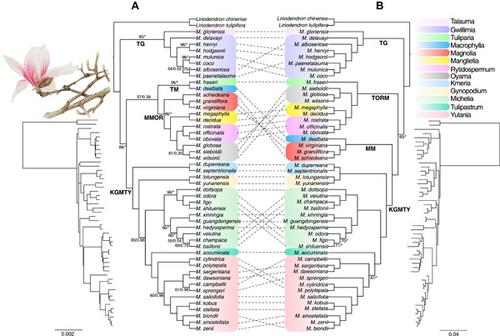当前位置:
X-MOL 学术
›
J. Syst. Evol.
›
论文详情
Our official English website, www.x-mol.net, welcomes your
feedback! (Note: you will need to create a separate account there.)
Plastid and nuclear phylogenomic incongruences and biogeographic implications of Magnolia s.l. (Magnoliaceae)
Journal of Systematics and Evolution ( IF 3.4 ) Pub Date : 2021-01-15 , DOI: 10.1111/jse.12727 Shanshan Dong 1 , Yaling Wang 2 , Nianhe Xia 3 , Yang Liu 1 , Min Liu 4 , Lian Lian 5 , Na Li 1 , Lingfei Li 1 , Xiaoan Lang 1 , Yiqing Gong 1 , Lu Chen 1 , Ernest Wu 6 , Shouzhou Zhang 1
Journal of Systematics and Evolution ( IF 3.4 ) Pub Date : 2021-01-15 , DOI: 10.1111/jse.12727 Shanshan Dong 1 , Yaling Wang 2 , Nianhe Xia 3 , Yang Liu 1 , Min Liu 4 , Lian Lian 5 , Na Li 1 , Lingfei Li 1 , Xiaoan Lang 1 , Yiqing Gong 1 , Lu Chen 1 , Ernest Wu 6 , Shouzhou Zhang 1
Affiliation

|
Magnoliaceae, an assemblage of early diverged angiosperms, comprises two subfamilies, speciose Magnolioideae with approximately 300 species in varying numbers of genera and monogeneric Liriodendroideae with two species in Liriodendron L. This family occupies a pivotal phylogenetic position with important insights into the diversification of early angiosperms, and shows intercontinentally disjunct distribution patterns between eastern Asia and the Americas. Widespread morphological homogeneity and slow substitution rates in Magnolia L. s.l. resulted in poorly supported phylogenetic relationships based on morphology or molecular evidence, which hampers our understanding of the genus’ temporal and spacial evolution. Here, based on the newly generated genome skimming data for 48 Magnolia s.l. species, we produced robust Magnolia phylogenies using genome-wide markers from both plastid genomes and single nucleotide polymorphism data. Contrasting the plastid and nuclear phylogenies revealed extensive cytonuclear conflicts in both shallow and deep relationships. ABBA-BABA and PhyloNet analyses suggested hybridization occurred within sect. Yulania, and sect. Magnolia, which is in concordance with the ploidy level of the species in these two sections. Divergence time estimates and biogeographic reconstruction indicated that the timing of the three tropical Magnolia disjunctions coincided with the mid-Eocene cooling climate and/or late Eocene climate deterioration, and two temperate disjunctions occurred much later, possibly during the warm periods of the Miocene, hence supporting the boreotropical flora concept of Magnolia s.l.
中文翻译:

Magnolia sl (Magnoliaceae) 的质体和核系统基因组不一致及生物地理学意义
Magnoliaceae 是早期分化的被子植物的集合,包括两个亚科,即 Magnolioideae,大约有 300 个不同属的物种,单属 Liriodendroideae,在Liriodendron L 中具有两个物种。该科在早期被子植物的多样化方面占有举足轻重的系统发育地位。 , 并显示了东亚和美洲之间的洲际分离分布模式。Magnolia L. sl 中广泛的形态同质性和缓慢的替代率导致基于形态或分子证据的系统发育关系支持不足,这阻碍了我们对该属的时间和空间进化的理解。在这里,基于新生成的 48Magnolia sl 物种,我们使用来自质体基因组和单核苷酸多态性数据的全基因组标记产生了强大的Magnolia系统发育。对比质体和核系统发育揭示了浅层和深层关系中广泛的细胞核冲突。ABBA-BABA 和 PhyloNet 分析表明杂交发生在教派内。Yulania和教派。玉兰,这与这两个部分的物种的倍性水平一致。分歧时间估计和生物地理重建表明三个热带木兰的时间分离与始新世中期冷却气候和/或始新世晚期气候恶化同时发生,并且两次温带分离发生得更晚,可能在中新世的温暖时期,因此支持了木兰的热带植物群概念
更新日期:2021-01-15
中文翻译:

Magnolia sl (Magnoliaceae) 的质体和核系统基因组不一致及生物地理学意义
Magnoliaceae 是早期分化的被子植物的集合,包括两个亚科,即 Magnolioideae,大约有 300 个不同属的物种,单属 Liriodendroideae,在Liriodendron L 中具有两个物种。该科在早期被子植物的多样化方面占有举足轻重的系统发育地位。 , 并显示了东亚和美洲之间的洲际分离分布模式。Magnolia L. sl 中广泛的形态同质性和缓慢的替代率导致基于形态或分子证据的系统发育关系支持不足,这阻碍了我们对该属的时间和空间进化的理解。在这里,基于新生成的 48Magnolia sl 物种,我们使用来自质体基因组和单核苷酸多态性数据的全基因组标记产生了强大的Magnolia系统发育。对比质体和核系统发育揭示了浅层和深层关系中广泛的细胞核冲突。ABBA-BABA 和 PhyloNet 分析表明杂交发生在教派内。Yulania和教派。玉兰,这与这两个部分的物种的倍性水平一致。分歧时间估计和生物地理重建表明三个热带木兰的时间分离与始新世中期冷却气候和/或始新世晚期气候恶化同时发生,并且两次温带分离发生得更晚,可能在中新世的温暖时期,因此支持了木兰的热带植物群概念











































 京公网安备 11010802027423号
京公网安备 11010802027423号